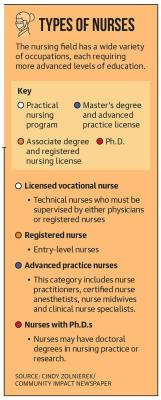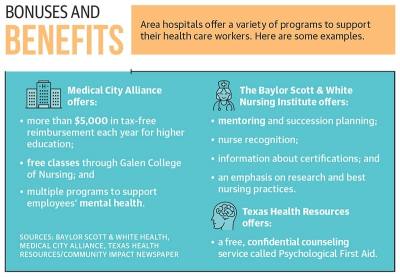The average number of weekly vacancies for the six months ending Dec. 4, 2021, was about 326 registered nurses, data showed. That compares with the more than 673 average number of weekly vacancies in the six-month period that ended June 4, 2022.
The numbers are part of a larger trend in nursing shortages that began long before COVID-19, experts say.
“The health care workforce is at a critical standpoint,” said Stephen Love, president and CEO of the Dallas-Fort Worth Hospital Council. “The COVID-19 pandemic took a very heavy toll on health care teams, especially on the front lines. As a result, many have suffered stress, trauma, burnout and behavioral health challenges.”
A 2018 study from the Texas Center for Nursing Workforce Studies projects that the state will be short nearly 60,000 nurses by 2032.
Ways to recruit, retain
Efforts are underway on numerous fronts both locally and at a broader level to take care of those nurses who are still on the job and to recruit more to join the profession.
“Nurses are at the forefront of the care we provide at Medical City Alliance,” said Dean Miller, the hospital’s chief nursing officer, in an email. “These nurses are not only skilled and compassionate caregivers, but provide valuable input into the policy and practice affecting patient care.”
Miller said because Medical City Alliance is part of a larger health care system, it shares resources across its 16 North Texas hospitals.
“Like hospitals across the country, we are seeing a shift in the labor force and inflationary pressures,” he said. “We have taken proactive steps to help ensure we have the expert talent we need for our patients.”
Among the benefits the health care system provides are access to more than $5,000 in tax-free reimbursement each year for higher education expenses, free classes through the Galen College of Nursing and a track as part of the Texas Two-Step program that offers a free nursing degree.
The Texas Nurses Association also has several programs in place to help. Its Nursing Shortage Reduction Program incentivizes schools to produce more graduates. The association also contributes to a Faculty Loan Repayment Program.
“The nursing shortage has two prongs to solve it,” said Cindy Zolnierek, CEO of the Texas Nurses Association. “One is producing more nurses, and the other end is keeping them. I think health care organizations are doing a lot to try to support particularly diverse staff, because if they support their staff, they’re likely to be loyal and want to stay with that organization.”
Love and Zolnierek both said the average age of nurses today and a shortage of nursing professionals in academia leave room for further shortages in the field.
“The work environment during COVID[-19] was so intense and so difficult for nurses that some are leaving nursing, or they may be taking a temporary break,” Zolnierek said. “Some are of an age where they’re able to retire or retire early, and we don’t fully understand the impact of that.”
On May 31, the Texas Workforce Commission voted to suspend certain program rules so that funds could be provided to train employees in public sector health care occupations. The funds were previously limited to private industry, according to a June 10 release from the commission.
A labor market analysis by the Texas Workforce Commission found a current gap of about 20,000 registered nurses in Texas, the release stated.
“Addressing the growing shortage of nurses in Texas continues to be my main focal point,” TWC Commissioner Representing Labor Julian Alvarez said in the release.
Many hospitals and organizations are offering support to those interested in entering the nursing workforce through grants and scholarships.
Baylor Scott & White Health, which has a hospital in Trophy Club, offers scholarships for nursing sciences, fellowship programs to transition nurses into new care settings and discussions on career goals, according to Matt Olivolo, who is a Baylor Scott & White Health marketing and public relations consultant.
“We continue to invest in our workforce, including offering competitive hiring bonuses for critical positions,” Olivolo said in a statement. “Additionally, we recently made a significant investment—totaling more than $164 million—by increasing the take-home pay of more than 12,000 frontline employees in nursing care roles.”
Zolnierek said now is a good time for young nurses to enter the workforce.
“Pre-COVID[-19], not all new graduates were finding jobs in hospitals,” Zolnierek said. “Now there are all kinds of opportunities.”
Focus on mental health
With the high demands and trauma that nurses have experienced during the pandemic, both Love and Zolnierek said burnout has become a serious concern.
“We’ve seen increased suicide among many different health care professions, and there’s an increasing attention beyond burnout,” Zolnierek said.
Many professional groups as well as employers, including hospitals, offer programs to help.
Medical City Alliance offers several programs to support employees’ mental health, Miller said. A program called Nurse Care helps hospital-based nurses with work-life balance and management of stress and anxiety. It also promotes self-care and handling common nursing issues, Miller said.
Another program called Code Compassion helps colleagues to recognize moments of crisis.
“Just as we would call a medical ‘Code Blue,’ if there is a trigger event, a colleague calls a ‘code compassion’ and sends out a message to the response team to provide support, recognition or resources to a colleague or team in need,” Miller said.
The hospital also offers a “Going Home Checklist” to remind staff “to pause and reflect before leaving and to turn our thoughts to restoration and home,” Miller said.
Texas Health, which has a hospital in the Alliance area, offers Psychological First Aid, a program used by the Red Cross and most states during disaster response. It offers its employees weekly voluntary virtual group sessions that are facilitated by licensed mental health providers, according to the health system. In 2019, about 70 people used this free, confidential counseling service. In 2020, more than 2,600 took part, according to Texas Health.
“Retaining employees, especially during the taxing times we’ve experienced in the pandemic, means systems must treat employees well, provide opportunities for career growth and resources to help care for their physical and mental health,” said Kelly Martin, vice president of human resources for Texas Health Resources, in an email.








